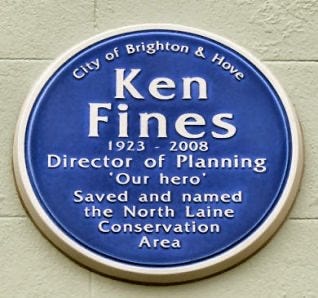"Designing a dream city is easy. Rebuilding a living one takes imagination."
These are the words of Jane Jacobs, the saviour of downtown New York. But they could just as well belong to Ken Fines, an unlikely visionary who saved the area now known as North Laine in Brighton from a hellish fate.
The beloved bohemian quarter has not always throbbed to the sound of buskers, lively bars and music teeming from busy shops. When London swung in the 1960s, the area north of Trafalgar Street featured a dispiriting mix of neglected terraced housing and dreary shops.
The local authority hired planning consultants Hugh Wilson and Lewis Womersley to produce a scheme that would propel the rundown area into a bright future. Their answer was unambiguous and perfectly in tune with the time: the car.
The interim plan published in 1968 called for new roads running east-west in parallel to the railway; roads would enclose the town centre; and a new elevated road would plough through the heart of the North Laine to bring traffic into the heart of the city and car parks in Church Street.
Fortunately, the council took fright at the suggestion and in 1973 a new plan was produced by a team from Brighton County Borough Council led by Ken Fines. Fines favoured conservation, calling for public transport and dumping the network of roads in favour of a bypass.
As Borough Planning Officer, Fines recommended the creation of new conservation areas areas and dubbed the area north of Trafalgar Square the North Laine. His genius was to realise that although the area lacked famous or prominent architecture, taken as a whole the area was unique.
In January 1976, a meeting held in a former school in Upper Gardner Street was packed by residents who demanded the area be saved. Fines took on board their wishes. He worked with residents and traders to arrest the planning blight and halt the demolitions The council approved a scheme to build houses on a derelict site in Frederick Street. The area’s future could begin to be gleaned.
It would be many years before the North Laine became a byword for alternative lifestyles, but thanks to a man who could not look less like a hipster, it had been saved from the worst excesses of insensitive planning.
On This Day
25 January 1799
The Sussex Weekly Advertiser reports on hopes for the cure of a painful condition.



